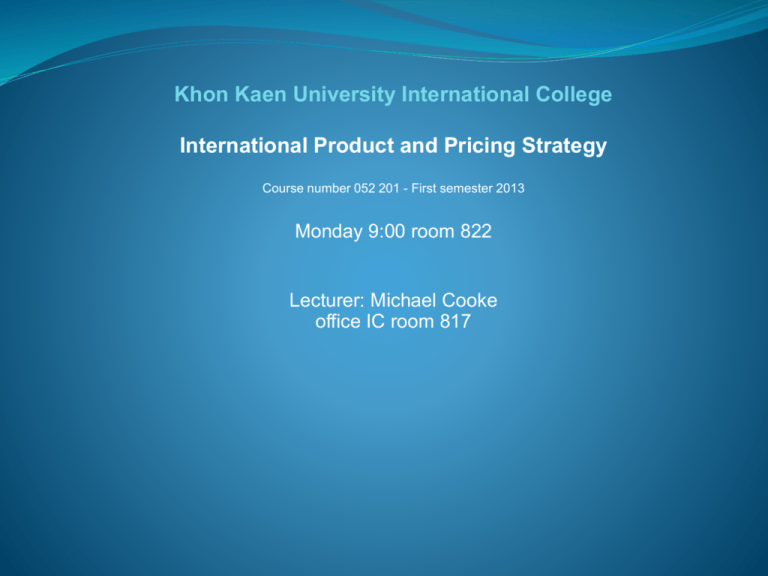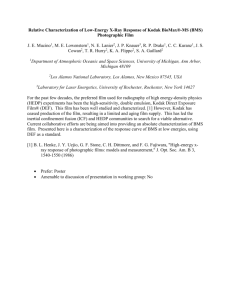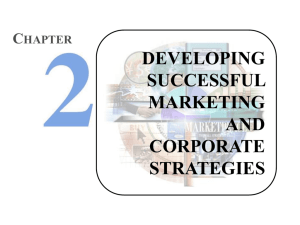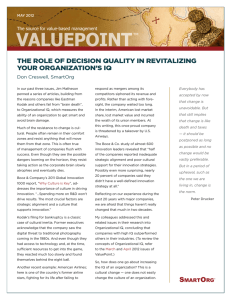GLOBAL PRODUCT POLICY 1: DEVELOPING NEW PRODUCTS
advertisement

Khon Kaen University International College International Product and Pricing Strategy Course number 052 201 - First semester 2013 Monday 9:00 room 822 Lecturer: Michael Cooke office IC room 817 Schedule for Next Two weeks Country study subjects and teams Review exam results Developing new products (19 August) Quiz Marketing products and services (26 August) Begin Pricing (26 August) Understand basic cost concepts Fixed cost Variable cost Cost absorption Read Zhang and Zhou 2 Mid-term Results The single biggest problem was leaving answers blank Especially happened on short answer As a general rule, never leave a blank answer Partial credit is better than no credit Sometimes students know more than they think Another common problem was not answering the question as asked Example is the essay about market entry via licensing or jv A well written answer gets only partial credit if it does not address the question Many of the essays were well written and showed insight Some unexpected answers got full credit In general, essays raised the grades (though few mentioned Brazil tariffs) 3 Project Presentation • Fifteen – twenty minutes for each team • Each member will participate in the presentation • Develop presentation material . Country study guidelines Research and analyze aspects of relevance to marketing a specific product in a target country Will be 20% of course grade Can discuss a country and advise that the country is not a suitable target Choose a product or service you choose to market internationally What is the target segment? What is your company’s risk tolerance? Is your company aggressive about international expansion? Discuss relevant aspects of the target country Market (segment size, wealth, other characteristics) Political and economic stability Relevant social characteristics Legal protection, barriers to entry, tariffs, etc. Competitive environment Infrastructure, distribution, available channels Conclusion Mode of entry, or no entry Magnitude of investment Presentations due (15-20 minutes) on September 9th 5 Introduction A cornerstone of a global marketing mix program is the set of product policy decisions that multinational companies (MNCs) constantly need to formulate. The range of product policy questions may include: What new products should be developed for what markets? What products should be added, removed, or modified for the product line in each of the countries in which the company operates? What brand names should be used? How should the product be packaged and serviced? Chapter 10 Copyright (c) 2009 John Wiley & Sons, Inc. 6 Examples of improper product policy decisions Ikea in the United States Products, prices, and service not adapted to US market Poor citing of stores Procter & Gamble in Australia Diapers manufactured outside of Australia (because of small market) Use of generic Asian packaging in Australia U.S. Car Makers in Japan Steering on left side American styling Cars could not get certified for small parking spaces Kodak’s venture into digital photography Digital photography invented at Kodak Institutional issues (legacy products) in their response to a disruptive technology 7 Eastman Kodak Company Background information Founded in 1880s, once an iconic US firm In 1976 Kodak sold between 85-90% of all film and cameras in the USA Fuji of Japan took market share in 1980s (economy segment) In 1994 Kodak 20th ranked US company by sales Kodak spins off Eastman Chemical, now thriving Apple launched a digital camera made by Kodak Kodak stops selling film cameras in 2004, becomes biggest retailer of digital cameras in 2005 Falls to 7th biggest digital camera retailer by 2010 Declares bankruptcy in 2012 8 Eastman Kodak Company Transition from Film Gross margins in the film business estimated at 75% Compare with computers and peripherals at 33% George Eastman wanted ‘rapid succession of changes and improvements’ Kodak had technological lead in film backed by patents Vertical integration and cost leadership Film sales immensely profitable Digital imaging a disruptive technology Kodak executives aware of digital camera trend from 1993* CEO Fisher from Motorola and Bell Labs hired 1993, a technologist Resistance by customers (film development business) Resistance from investors (legacy business as ‘cash cow’) Company culture resistance (film business, not imaging) Public image of support for film business through 1990s CEOs aware of competitive environment, no barriers to entry in digital, lower margins Collaboration with Canon in 2000 (professional segment) Collaboration with Fuji, HP, IBM, others to develop digital image storage By late 1990s Kodak was leader in digital color management and electronic image sensors due to huge digital R&D effort **http://www.blackwellpublishing.com/grant/docs/06Kodak.pdf 9 Eastman Kodak Company What Went Wrong? Conflicts between film and digital began to ebb around 2005 More collaborative culture Ten years elapsed since CEO Fisher began determined push to digital Leader in digital sales in 2005 Losing money on each camera Legacy labor costs* Vertical integration impossible in digital business (JVs, alliances instead) Diminished film business (would have been used to subsidize transition) Tried to buy time by selling film in developing markets But Asian film sales dropped as rapidly as elsewhere Falls to seventh rank in digital camera sales in 2010 Capable competitors Canon, Sony, Samsung, and Nikon in Asia and others Pace of change in digital camera business rapid and unpredictable, with rapidly declining prices Could Kodak’s culture adapt to digital’s pace of change? Did they miss a product cycle in 2007? What happened in their R&D organization? Marketing? *Http://www.consultingcase101.com/kodak-to-improve-profit-margin-for-digital-cameras/ 10 Booz & Co. R&D Survey 2011 http://www.booz.com/global/home/press/article/49852237 Study of 1,000 public companies that spent the most on research and development in 2010 Total for the 1,000 $550 bb Computing and electronics 28% of all R&D expenditure Health care (pharmaceuticals) 22% Automotive 15% of all R&D expenditures China and India HQ companies = 2% of total R & D Spending doesn’t correlate successful innovation “There is no statistically significant relationship between financial performance and innovation spending, in terms of either total R&D dollars or R&D as a percentage of revenues.” according to Booz & Co Most innovative firms were Apple, Google, and 3M Samsung and Toyota were big spenders and innovative The key finding: culture is key to innovation success According to 3M: “Our goal is to get the voice of the customer all the way back to the basic research level and the product development level, to make sure our technical people see how their technologies work in various market conditions.” 11 Booz & Co. R&D Survey 2011 http://www.booz.com/global/home/press/article/49852237 Need Seekers, Market Readers and Technology Drivers Need Seekers consistently strive to be first movers and proactively engage customers to shape new innovations, and align innovation and business strategies (3M) Market Readers adopt a second mover strategy and emphasize incremental change (Samsung) Technology Drivers stress technology achievement and both incremental and breakthrough change (Google) If you align innovation strategy and culture to your business model, build the right capabilities, and execute, you can prevail no matter which strategy you follow There may be no more critical source of business success or failure than a company’s culture. It is more important than strategy and leadership. According to Booz & Co.: Companies whose strategic goals are clear, and whose cultures strongly support those goals, possess a huge advantage “Connect with the customer, find out their articulated and unarticulated needs, and then determine the capability at 3M that can be developed across the company that could solve that customer’s problem in a unique, proprietary, and sustainable way. Our businesses are all interdependent and collaborative.” Booz & Co. R&D Survey – 2011* Most often cited strategic goals of innovation are: Superior product performance Superior product quality Cultural attributes: Strong identification with the customer Pride in products Need seekers: Gaining insights on customers needs is the responsibility of all customer-facing employees. Silicon Valley companies are almost twice as likely as average companies to have capabilities that provide a superior understanding of the stated and unstated needs of their end customers Technological advances that lead to products and services that gain traction in the marketplace come through superior insight into customers, as well as the development of practical value propositions that will win those customers business 6/10 of the most innovative were need seekers 2/10 of the biggest spenders were need seekers *http://www.booz.com/media/uploads/BoozCo-Global-Innovation-1000-2011-Culture-Key.pdf 13 Booz & Co. R&D Survey Top 12 R&D in 2010 Excluding Health Rank list Rank all Company R&D $BB % sales Region 1 4 Microsoft 8.7 14 US 2 6 Toyota 8.5 4 Asia 3 7 Samsung 7.9 6 Asia 4 8 Nokia 7.8 14 Europe 5 9 General Motors 7.0 5 US 6 11 Intel 6.6 15 US 7 12 Panasonic 6.1 6 Asia 8 14 VW 6.1 4 Europe 9 15 IBM 6.0 6 US 10 17 Honda 5.7 6 Asia 11 19 Cisco 5.3 13 US 12 20 Siemens 5.2 5 Europe http://www.booz.com/media/uploads/BoozCo-Global-Innovation-1000-2011-Culture-Key.pdf 14 Booz & Co. R&D Survey 2011 Innovation As part of this year’s study, Booz & Co. surveyed almost 600 innovation leaders in companies around the world, large and small, in every major industry sector. As noted, almost half of the companies reported inadequate strategic alignment and poor cultural support for their innovation strategies. Possibly even more surprising, nearly 20 percent of companies said they didn’t have a well defined innovation strategy at all. http://www.booz.com/media/uploads/BoozCo-Global-Innovation-1000-2011-Culture-Key.pdf 15 Booz & Co. R&D Survey Top 10 Innovative Companies in 2010 Rank Company R&D $BB % sales Spend rank 1 Apple $1.8 2.7 70 2 Google $3.8 12.8 34 3 3M $1.4 5.4 86 4 GE $3.9 2.6 32 5 Microsoft $14.0 14.0 4 6 IBM $6.0 6.0 15 7 Samsung $5.9 5.9 7 8 P&G $2.5 2.5 61 9 Toyota $3.9 3.9 6 10 Facebook na na na http://www.booz.com/media/uploads/BoozCo-Global-Innovation-1000-2011-Culture-Key.pdf 16 Developing New Products for Global Markets The Role of Corporate R&D Very few companies do early stage research In the past Bell Labs, Xerox (PARC) and IBM had renowned research “What used to be spent on an in-house division is now spent on sponsorship of university research and the acquisition of intellectual property from smaller companies. The few exceptions to this rule (Google labs?) seem to be for companies that have trade secret protection as a viable alternative to patenting” (1) Enormous expense of basic research often shared IBM, Samsung, Intel, Global Foundries, and TMSC share cost of $4.4BB R&D center and collaborate with SUNY on cost technology SEMATECH launched with US government assistance in 1987 Common model is to focus R&D effort on identifying available technologies or to reducing costs License from other companies, or buy smaller companies with promising technology as Kodak did in the late 90s and early 2000s Open source and creative commons movements Free copying of computer source code or copyrighted material under conditions Value of expanding the product category (more on this in branding) (1)http://www.patenthawk.com/blog/2008/03/did_bayhdole_end_corporate_rd.html 17 R&D as % of GDP - selected EU and non-EU countries, 2006* * http://www.voxeu.org/article/rd-missing-wrong-targets Country Variation in R&D Intensity (1) Technological specialization explains the variation in R&D intensity better than any other country characteristics. When industrial specialization is taken into account, only Sweden and the US still outperform other countries. Neither Japan nor Finland has an R&D intensity that is particularly high in relation to what their industrial structures would suggest. A country specialized in the finance industry (e.g., Luxemburg) would not need a high level of R&D expenditure in order to ensure growth. Similarly, a country specialized in the tourism, fashion, services or food industries would have a lower R&D intensity than a country specialized in the pharmaceutical, engineering or biotech industries. The four European countries with the highest academic R&D intensities are also the four countries with the highest business R&D intensities. With effective technology transfer systems in place, academic research is probably the most effective source of new ideas, which in turn induce further research in the business sector. http://www.voxeu.org/article/rd-missing-wrong-targets 19 Developing New Products for Global Markets The Role of Universities Corporate collaboration with universities Research oriented universities have technology transfer offices – and typically license intellectual property Companies might have a need to fill a hole in product line Corporate R&D’s role is to find and evaluate the technology IBM has research centers in nine countries * Close links to universities in India, for example Seeks collaboration as well as a role in developing future staff University faculty or graduate students may form companies Develop products from early stage university lab ideas Small companies often sold to large organizations or do licensing Some go on to become highly successful industry pioneers Genentech (University of CA) in biotech Google (Stanford) internet technology Sun Microsystems (UC and Stanford) computers and software SAS (NCSU led consortium) statistical analysis software * http://www-07.ibm.com/in/research/univrelations.html 20 Global Product Development Overview 1.Global Product Strategies 2.Standardization Versus Customization 3.Multinational Diffusion 4.Developing New Products for Global Markets 5.Truly Global Product Development Chapter 10 Copyright (c) 2009 John Wiley & Sons, Inc. 21 Global Product Strategies Three global strategies to penetrate foreign markets Extension strategy – Product or communication same as home country Adaptation strategy - Product or communication adapted to host country market Invention strategy – Products designed for a global market Chapter 10 22 Global Product Strategies Five strategic options for the global marketplace Strategic Option 1: Product and Communication Extension -- Dual Extension Scale economies in both product and advertising Global segments or companies with resource limitations Strategic Option 2: Product Extension -- Communications Adaptation Wrigley example: Same product advertised as having differing benefits across cultures Retains advantages of manufacturing scale Strategic Option 3: Product Adaptation -- Communications Extension Typical when companies add brands via purchase of local companies Similar consumer values favor communication extension Strategic Option 4: Product and Communications Adaptation -- Dual Adaptation Strategic Option 5: Product Invention 23 Exhibit 10-1: Global Expansion Strategies Chapter 10 Copyright (c) 2009 John Wiley & Sons, Inc. 24 Standardization versus Customization Five forces favoring a globalized product strategy Common customer preferences (Exhibit 10-2) 1. Global customers (business to business) 2. Global companies may have centralized sourcing Global customers often prefer identical products/services Scale economies 3. Sourcing efficiencies or R&D efficiencies Economies of scale have limits in some industries (timeliness factor) Time to market – need for speed 4. 5. Similar use functions across cultures Similar use conditions or benefits (example: stylishness) Short product life cycles Focus R&D and product development efforts on a few projects Regional market agreements (such as single European market) facilitate standardization 25 Exhibit 10-2: 2008 Automotive Color Popularity Chapter 10 Copyright (c) 2007 John Wiley & Sons, Inc. 26 Exhibit 10-2 (cont): 2008 Automotive Color Popularity Chapter 10 Copyright (c) 2007 John Wiley & Sons, Inc. 27 Exhibit 10-2 (cont): 2008 Automotive Color Popularity Chapter 10 Copyright (c) 2007 John Wiley & Sons, Inc. 28 Degrees of Global Customization Modular Approach Mass produce standard components (engines, gears, etc) Assemble to local requirements or tastes(Deere example) Core-Product (Common Platform) Approach Mass produce core product Add attachments for local needs or tastes (auto heaters) Standardization versus adaptation Too much standardization stifles local initiative Over-customization = competition with local products Costs of tailoring to local markets (break-even analysis) 29 Multinational Diffusion – Product Acceptance Individual differences (willingness to try new products) Early adopters like to experiment with new products Late adopters wait, learn from prior adopters Social influences (peer influence) Product characteristics 1. Relative advantage or perceived value over alternatives 2. Compatibility with existing social norms Switching costs? Consistent with existing social values? 3. Complexity or ease of use 4. Ability to test or try on limited basis 5. Are benefits easy to observe or communicate? Chapter 10 30 Multinational Diffusion Market penetration rate of a product differs among countries Country characteristics used to predict new product penetration patterns include: Homogeneous populations adopt products faster Lead countries are where product is first introduced Lag countries have higher adoption rates (time to study) Cosmopolitanism is degree to which people look beyond local environment. Cosmopolitans adopt more quickly. Mobility and ability to interact helps penetration Labor force profile – women in workforce tend to facilitate certain types of innovations Speed of penetration varies among products and countries Decreases with time (more recent = faster penetration) Small consumer electronics take off faster than appliances Newly developed countries-take off faster than Europe Take-off is time from introduction to growth stage in product life cycle Exhibit 10-3 dated 2008 31 Exhibit 10-3: Mean Time to Take Off Across Product Categories within a Country Chapter 11 Copyright (c) 2007 John Wiley & Sons, Inc. 32 Developing New Products for Global Markets Identifying New Product Ideas 4 C’s: Company (internal sources) Transplant ideas from one region to another R&D, sales, market research, other employees Customers The most difficult customers are often the best In most cases initial marketing is to mid-level analysts Analysts review product, make recommendations to executives Difficult customers may become beta sites Suggest improvements, additional features, new approach Competition Collaborators – suppliers, distributors, etc. Innovation Centers – teams to develop new products Institutional barriers to innovation among companies with dominant products Kodak in the 1990s Microsoft after 2000 Role of bureaucracy Threat to profits of legacy products 33 Developing New Products for Global Markets New Product Development New Product Development Nearly ¾ of the 30 biggest selling products worldwide had origins in marketing or manufacturing * Use of global reach to move ideas from one part of the world to another Alpha and beta test feedback may suggest changes Some companies set up small incubator units or innovation centers Working with distributors or producers of complementary products Watching competitors Screening Product ideas from marketplace most likely to succeed Product advantage (superiority to competitors, unique features) a major success factor Powerful brand associations generate acceptance (trust feature?) Consumer characteristics – younger consumers are more likely to try new products Concept Testing – detailed description of the product Focus groups – small groups of prospective customers “Red Bull” concept rejected all around – concept testing is imperfect Test marketing May be skipped to save money Lead markets can be used as projections (Exhibit 10-4) Timing of Entry (Exhibit 10-5) Waterfall—staged rollout beginning with home country favored if: Long product life cycle Unfavorable host market conditions Sprinkler—global rollout simultaneously motivated by: Competitor concerns Universal segments *Czinkota and Ronkainan “International Marketing 8E” US, Thomson, 2007 p476 34 Exhibit 10-4: Examples of Test Market Countries Chapter 11 Copyright (c) 2007 John Wiley & Sons, Inc. 35 Exhibit 10-5: Waterfall versus Sprinkler Models Chapter 10 Copyright (c) 2009 John Wiley & Sons, Inc. 36 Exhibit 10-6: Roll-Out of Xbox 360 and Sony Playstation 3 Chapter 11 Copyright (c) 2007 John Wiley & Sons, Inc. 37 Truly Global Product Development Companies have research centers across the world. Few have set up a global product development process Lack access to regional talent Establish a global innovation process across regions (Nokia uses ideas from UK, USA, Japan, and Italy) To harvest the benefits of multi-region innovation: Prospecting- Find valuable new pockets of knowledge around the world. Assessing- Decide on the right number of sources Mobilize – Link knowledge clusters (Exhibit 10-7) 38 Exhibit 10-7: Mobilizing Knowledge Chapter 10 Copyright (c) 2009 John Wiley & Sons, Inc. 39





